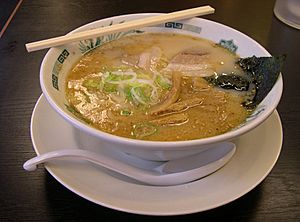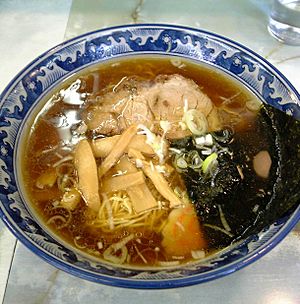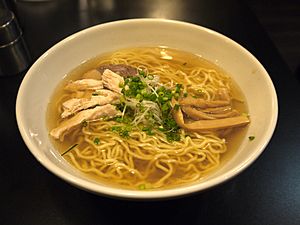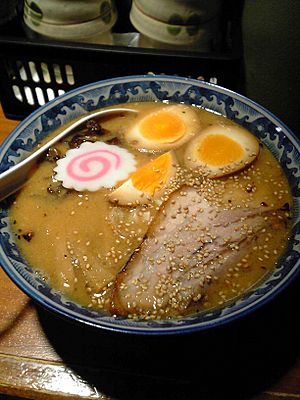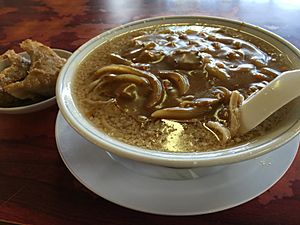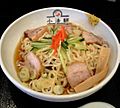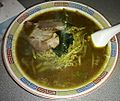Ramen facts for kids
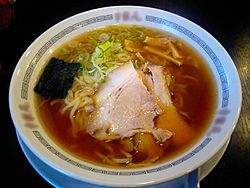
Shōyu (soy-based broth) ramen
|
|
| Alternative names | shina soba, chūka soba |
|---|---|
| Type | Noodle soup |
| Place of origin | Japan |
| Region or state | Yokohama Chinatown |
| Serving temperature | Hot |
| Main ingredients | Chinese wheat noodles, meat- or fish-based broth, vegetables or meat |
| Variations | Many variants, especially regional, with various ingredients and toppings |
Ramen is a Japanese kind of noodle soup. The noodles are made of wheat. Ramen are typically Japanese, though they originally came from China. Ramen has become very popular in Japan and there are many shops that sell it. Japanese also make "instant ramen" to eat ramen quickly and easily at home. Outside Japan, people have also started to eat ramen.
On the model of Spaghetti Western, there are even movies based on Ramen.
There are various types of thickness, shapes and lengths. The noodle may be thin or thick, straight or wrinkled.
In Japan, there are unique local Ramen in various areas where local tastes are enjoyed. It is called "gotouchi ramen" in Japan. For example, Hakata ramen is known for its pork ramen soup. The noodles are very thin and does not need to be boiled for very long to become soft. Sapporo ramen is known for its miso ramen soup. And Kitakata ramen is known for its Shoyu ramen soup. Shio (salty) ramen is also a popular flavor. These days, Gyokai-tonkotsu ramen is also popular.
Contents
History
Origin
Ramen is a Japanese adaptation of Chinese wheat noodles. One theory says that ramen was first introduced to Japan during the 1660s by the Chinese neo-Confucian scholar Zhu Shunsui who served as an advisor to Tokugawa Mitsukuni after he became a refugee in Japan to escape Manchu rule and Mitsukuni became the first Japanese person to eat ramen, although most historians reject this theory as a myth created by the Japanese to embellish the origins of ramen. The more plausible theory is that ramen was introduced by Chinese immigrants in the late 19th or early 20th century at Yokohama Chinatown. According to the record of the Yokohama Ramen Museum, ramen originated in China and made its way over to Japan in 1859. Early versions were wheat noodles in broth topped with Chinese-style roast pork.
Etymology
The word ramen is a Japanese transcription of the Chinese lamian (拉麵). In 1910, the first ramen shop named RAIRAIKEN(ja:来々軒) opend at Asakusa, Tokyo, where the Japanese owner employed 12 Cantonese cooks from Yokohama's Chinatown and served the ramen arranged for Japanese customers. Until the 1950s, ramen was called shina soba (支那そば, literally "Chinese soba") but today chūka soba (中華そば, also meaning "Chinese soba") or just ramen (ラーメン) are more common, as the word "支那" (shina, meaning "China") has acquired a pejorative connotation.
Initial appearance
By 1900, restaurants serving Chinese cuisine from Canton and Shanghai offered a simple ramen dish of noodles (cut rather than hand-pulled), a few toppings, and a broth flavored with salt and pork bones. Many Chinese living in Japan also pulled portable food stalls, selling ramen and gyōza dumplings to workers. By the mid-1900s, these stalls used a type of a musical horn called a charumera (チャルメラ, from the Portuguese charamela) to advertise their presence, a practice some vendors still retain via a loudspeaker and a looped recording. By the early Shōwa period, ramen had become a popular dish when eating out.
According to ramen expert Hiroshi Osaki, the first specialized ramen shop opened in Yokohama in 1910.
Postwar popularization
After Japan's defeat in World War II, the American military occupied the country from 1945 to 1952. In December 1945, Japan recorded its worst rice harvest in 42 years, which caused food shortages as Japan had drastically reduced rice production during the war as production shifted to colonies in China and Taiwan. The US flooded the market with cheap wheat flour to deal with food shortages. From 1948 to 1951, bread consumption in Japan increased from 262,121 tons to 611,784 tons, but wheat also found its way into ramen, which most Japanese ate at black market food vendors to survive as the government food distribution system ran about 20 days behind schedule. Although the Americans maintained Japan's wartime ban on outdoor food vending, flour was secretly diverted from commercial mills into the black markets, where nearly 90 percent of stalls were under the control of gangsters locally referred to as yakuza who extorted vendors for protection money. Thousands of ramen vendors were arrested during the occupation. In the same period, millions of Japanese troops returned from China and continental East Asia from their posts in the Second Sino-Japanese War. Some of them would have been familiar with wheat noodles. By 1950 wheat flour exchange controls were removed and restrictions on food vending loosened, which further boosted the number of ramen vendors: private companies even rented out yatai starter kits consisting of noodles, toppings, bowls, and chopsticks. Ramen yatai provided a rare opportunity for small scale postwar entrepreneurship. The Americans also aggressively advertised the nutritional benefits of wheat and animal protein. The combination of these factors caused wheat noodles to gain prominence in Japan's rice-based culture. Gradually, ramen became associated with urban life.
Modern period
In 1958, instant noodles were invented by Momofuku Ando, the Taiwanese-Japanese founder and chairman of Nissin Foods. Named the greatest Japanese invention of the 20th century in a Japanese poll, instant ramen allowed anyone to make an approximation of this dish simply by adding boiling water.
Beginning in the 1980s, ramen became a Japanese cultural icon and was studied around the world from many perspectives. At the same time, local varieties of ramen were hitting the national market and could even be ordered by their regional names. A ramen museum opened in Yokohama in 1994.
Today ramen is arguably one of Japan's most popular foods, with Tokyo alone containing around 5,000 ramen shops, and more than 24,000 ramen shops across Japan. Tsuta, a ramen restaurant in Tokyo’s Sugamo district, received a Michelin star in December 2015.
Types
A wide variety of ramen exists in Japan, with geographical and vendor-specific differences even in varieties that share the same name. Ramen can be broadly categorized by its two main ingredients: noodles and broth.
Noodles
Most noodles are made from four basic ingredients: wheat flour, salt, water, and kansui (かん水) (from kansui (鹹水, salt water)) a type of alkaline mineral water, containing sodium carbonate and usually potassium carbonate, as well as sometimes a small amount of phosphoric acid. Although Ramen noodles and Udon noodles are both made with wheat, they are different kinds of noodle.
The kansui is the distinguishing ingredient in ramen noodles, and originated in Inner Mongolia, where some lakes contained large amounts of these minerals and whose water is said to be perfect for making these noodles. Making noodles with kansui lends them a yellowish hue as well as a firm texture. Eggs may also be substituted for kansui. Some noodles are made with neither eggs nor kansui and should only be used for yakisoba, as they have a weaker structure and are more prone to soaking up moisture and becoming extremely soft when served in soup.
Ramen comes in various shapes and lengths. It may be thick, thin, or even ribbon-like, as well as straight or wrinkled.
Traditionally Ramen noodles were made manually, but with growing popularity many Ramen restaurants prefer to have in-house capacity to produce fresh noodles to meet the increased demand and improve quality. Automatic Ramen making machines imitating manual production methods have been available since the mid. 20th century produced by such Japanese manufacturers as Yamato MFG. and others.
Soup
Ramen soup is generally made from stock based on chicken or pork, combined with a variety of ingredients such as kombu (kelp), katsuobushi (skipjack tuna flakes), niboshi (dried baby sardines), beef bones, pork bones, shiitake, and onions. Some modern Ramen broths can also be vegetable based.
Flavours
The resulting combination is generally divided into four categories. (although new and original variations often make this categorization less clear-cut) Described from old ones.
- Tonkotsu (豚骨, "pork bone"; not to be confused with tonkatsu) soup usually has a cloudy white colored broth. It is similar to the Chinese baitang(白湯) and has a thick broth made from boiling pork bones, fat, and collagen over high heat for many hours, which suffuses the broth with a hearty pork flavor and a creamy consistency that rivals milk, melted butter or gravy (depending on the shop).
- Shōyu (醤油, "soy sauce") ramen has a clear brown broth, based on a chicken and vegetable (or sometimes fish or beef) stock with plenty of soy sauce added resulting in a soup that is tangy, salty, and savory yet still fairly light on the palate. Shōyu ramen usually has curly noodles rather than straight ones, but this is not always the case. It is often adorned with marinated bamboo shoots or menma, green onions, ninjin (carrot), kamaboko (fish cakes), nori (seaweed), boiled eggs, bean sprouts or black pepper; occasionally the soup will also contain chili oil or Chinese spices, and some shops serve sliced beef instead of the usual chāshū.
- Shio (塩,"salt") ramen is the oldest of the four types. It has a pale, clear, yellowish broth made with plenty of salt and any combination of chicken, vegetables, fish, and seaweed. Occasionally pork bones are also used, but they are not boiled as long as they are for tonkotsu ramen, so the soup remains light and clear. Chāshū is sometimes swapped for lean chicken meatballs, and pickled plums and kamaboko (a slice of processed fish roll sometimes served as a frilly white circle with a pink or red spiral called narutomaki) are popular toppings as well. Noodle texture and thickness varies among shio ramen, but they are usually straight rather than curly.
- Miso (味噌) ramen is a relative newcomer, having reached national prominence around 1965. This uniquely Japanese ramen, which was developed in Hokkaido, features a broth that combines copious miso and is blended with oily chicken or fish broth – and sometimes with tonkotsu or lard – to create a thick, nutty, slightly sweet and very hearty soup. Miso ramen broth tends to have a robust, tangy flavor, so it stands up to a variety of flavorful toppings: spicy bean paste or tōbanjan (豆瓣醤), butter and corn, leeks, onions, bean sprouts, ground pork, cabbage, sesame seeds, white pepper, and chopped garlic are common. The noodles are typically thick, curly, and slightly chewy.
- Karē (カレー,"curry") ramen, ramen cooked with curry soup, is thought that was born spontaneously relatively recently in Japan. In Japan, several cities claim their origins. Muroran city claims, it occurred in there in 1965 (see also Muroran curry ramen). Also, Sanjō city claims, it founded over 80 years ago. Katori city claims also. Curry soup is mainly made with pork bones and vegetables and is seasoned with curry. The noodles are thick and curly. Toppings include chāshū, wakame, and bean sprouts.
Toppings
After basic preparation, ramen can be seasoned and flavored with any number of toppings, including but not limited to:
- Chāshū (sliced barbecued or braised pork)
- Negi (green onion)
- Takana-zuke (Pickled and seasoned mustard leaves)
- Seasoned (usually salted) boiled egg
- Bean or other sprouts
- Menma (lactate-fermented bamboo shoots)
- Kakuni (braised pork cubes or squares)
- Nori (dried seaweed)
- Kamaboko (formed fish paste, often in a pink and white spiral called narutomaki)
- Corn
- Butter
- Wakame (a type of marine algae)
- Olive Oil
Images for kids
See also
 In Spanish: Ramen para niños
In Spanish: Ramen para niños



